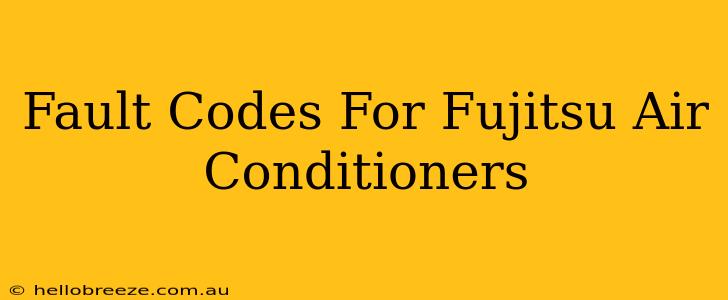Finding your Fujitsu air conditioner displaying a cryptic error code can be frustrating. This guide breaks down common Fujitsu air conditioner fault codes, helping you diagnose the problem and potentially save on costly service calls. Understanding these codes empowers you to take control and ensure your home stays comfortably cool.
Understanding Fujitsu Air Conditioner Error Codes
Fujitsu air conditioners use a system of flashing lights or digital displays to indicate malfunctions. These error codes represent specific issues within the unit, ranging from minor problems easily solved to more serious concerns requiring professional attention. It's crucial to note that the specific codes and their meanings may vary slightly depending on your model. Always refer to your user manual for the most accurate interpretation.
Common Fujitsu Air Conditioner Error Codes & Their Meanings
Below are some of the most frequently encountered Fujitsu air conditioner fault codes. This isn't an exhaustive list, so always check your user manual for model-specific information.
-
Code E0: This often indicates a general malfunction within the system. It's a broad error code that requires a thorough inspection by a qualified technician. Don't attempt DIY repairs with this code.
-
Code E1: This code frequently points to a problem with the indoor unit's fan motor. The fan might be obstructed, faulty, or experiencing a power issue. Check for obstructions and ensure the fan blades spin freely. If the problem persists, professional assistance is recommended.
-
Code E2: Similar to E1, this code often points to an issue with the outdoor unit's fan motor. Again, check for obstructions. Leaves, debris, or even small animals can impede the fan's operation. If the problem continues, call a qualified technician.
-
Code E3: This code frequently signifies a problem with the refrigerant. Low refrigerant levels often necessitate a professional recharge. Refrigerant handling requires specialized knowledge and equipment. Never attempt to handle refrigerant yourself.
-
Code E4: This code commonly points towards a communication problem between the indoor and outdoor units. This could be a wiring issue, a faulty communication board, or a problem with the sensor. Professional service is usually needed.
-
Code E5: This error code often signals a problem with the temperature sensor. An inaccurate temperature reading can prevent the unit from operating correctly. A qualified technician will need to investigate and potentially replace the sensor.
-
Code E6: This code usually relates to problems with the compressor, a crucial component for cooling. Compressor issues are usually serious and require immediate attention from a qualified technician.
-
Code E7: This often signifies a problem with the defrost sensor or the defrosting cycle. It's common in units with heat pump functionality. Professional service is recommended.
Troubleshooting Steps Before Calling for Service
Before calling a repair technician, consider these basic troubleshooting steps:
- Check the power supply: Ensure the air conditioner is properly plugged in and receiving power. Check the circuit breaker to make sure it hasn't tripped.
- Inspect for obstructions: Clear any debris or obstructions around both the indoor and outdoor units.
- Check the air filters: Dirty air filters restrict airflow and can cause malfunctions. Clean or replace the filters as needed. This is often the easiest fix and should be done regularly as part of preventative maintenance.
Preventing Future Problems: Regular Maintenance is Key
Regular maintenance is crucial for preventing air conditioner problems and extending its lifespan. This includes:
- Regular filter changes: Follow the manufacturer's recommendations for filter replacement.
- Annual professional maintenance: Schedule a yearly checkup by a qualified technician to identify and address potential issues before they escalate.
- Keep the units clean: Regularly clean the fins on both the indoor and outdoor units.
By understanding common Fujitsu air conditioner fault codes and taking proactive steps, you can significantly improve the efficiency and longevity of your system and avoid costly repairs down the line. Remember, when in doubt, consult your user manual or contact a qualified Fujitsu technician.

